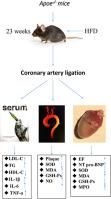Biochemical and Biophysical Research Communications ( IF 2.5 ) Pub Date : 2021-08-31 , DOI: 10.1016/j.bbrc.2021.08.006 Jianbing Wang 1 , Shijun Shan 2 , Anqi Lyu 2 , Yinsheng Wan 3 , Jun Zhang 4

|
Rationale
Coronary artery ligation to induce myocardial infarction (MI) and ischemia injury in mice is typically performed in normal mice, but This is not consistent with disease progression. There should be atherosclerosis (AS) first, followed by MI.
Objective
We tried a novel model to induce MI that was established on atherosclerosis in mice. This approach was much more consistent with disease progression.
Methods
In this study, Mice lacking apolipoprotein E (ApoE−/-) were randomly divided into four groups. The mice of the control and MI groups were fed normal diet for 24-weeks, while the mice of AS and AS + MI groups were fed high-fat diet (HFD). After 23 weeks, the mice of MI and AS + MI groups were ligated with coronary arteries. A week later, after echocardiography, analysis of plaque and myocardium were conducted on aortic and heart, then the serum, aorta and heart tissues were further detected.
Results
Our results showed that AS model mice exhibited significant body weight gain, dyslipidemia and atherosclerotic lesions formation which were in accordance with the pathological changes of AS. Co-treatment with AS and MI led to higher operative mortality and heart pathological were in accordance with the pathological changes of MI. In addition, Echocardiography and NT pro-BNP revealed co-treatment with AS and MI led to deterioration of cardiac function. AS also aggravated myocardial inflammatory cell infiltration and fibrosis post-MI.
Conclusions
Together, it is feasible to establish myocardial infarction model based on atherosclerosis model.
中文翻译:

基于小鼠动脉粥样硬化的新型心肌梗死模型
基本原理
冠状动脉结扎诱导小鼠心肌梗塞 (MI) 和缺血性损伤通常在正常小鼠中进行,但这与疾病进展不一致。首先应该是动脉粥样硬化 (AS),然后是 MI。
客观的
我们尝试了一种新的模型来诱导小鼠动脉粥样硬化的 MI。这种方法更符合疾病进展。
方法
在这项研究中,缺乏载脂蛋白 E (ApoE -/- ) 的小鼠被随机分为四组。对照组和MI组小鼠饲喂正常饮食24周,AS组和AS+MI组小鼠饲喂高脂饮食(HFD)。23周后,MI组和AS+MI组小鼠冠状动脉结扎。一周后,超声心动图后,对主动脉和心脏进行斑块和心肌分析,然后进一步检测血清、主动脉和心脏组织。
结果
我们的研究结果表明,AS模型小鼠表现出显着的体重增加、血脂异常和动脉粥样硬化病变的形成,这与AS的病理变化是一致的。AS和MI联合治疗导致较高的手术死亡率,心脏病理符合MI的病理变化。此外,超声心动图和 NT pro-BNP 显示同时治疗 AS 和 MI 导致心脏功能恶化。AS还加重MI后心肌炎性细胞浸润和纤维化。
结论
综上所述,基于动脉粥样硬化模型建立心肌梗死模型是可行的。











































 京公网安备 11010802027423号
京公网安备 11010802027423号